- Home
- Cooking
- Roasting
- Frying
- Stir Frying
- Braising
- Steaming
- Baking
- Marinating
- Grilling
- Candy Making
- Deep-Frying
- En Papillote
- Curing
- Glaze
- Skewers and Kebabs
- Infusion
- Juicing
- Gravies and Sauces
- Making Pasta
- Outdoor Cooking
- Poaching
- Reduction
- Sautéing
- Soups and Broths
- Preserving Methods
- Fondue Methods
- Pané Methods
- Making Stocks
- Making Bread
- Griddling Methods
- Savoury Bakes
- Stews
- Making Salads
- About Cooking Crashes
- My Man's Cooking
- Patés and Terrines
- Roasting Meat
- Gardening
- Recipes
- Cakes and Bakes
- Fish
- Desserts
- Soups
- Stir Fry
- Meat
- Starters
- Snacks
- Smoothies
- Brunch
- Savoury Pies
- Vegetarian
- Salads
- Pasta
- Rice Dishes
- Picnic
- Stews
- Jams and Chutneys
- Burgers and Meatballs, Vegballs and Fishballs.
- Festive Recipes
- Sides
- Breakfast
- Pizza and Tartiflette
- Lunch
- BBQ and Grill
- Savoury Bakes and Gratins.
- Fondues
- Raclettes
- Leftover Recipes
- Sauces, Vinaigrettes, Dressings and Dips
- My Recipes
- Seasonal
- Tips
- Ingredients
- Cheese
- Fruits
- Vegetables
- Meat
- Fish
- Eggs
- Breads and Bakes
- Spices
- Herbs
- Sauces, Pastes and Stocks.
- Nuts
- Dairy
- Condiment
- Seaweeds
- Baking Ingredients
- Seeds
- Pastas and Noodles
- Pastries and Batters
- Shellfish and Seafood
- Oils, Vinegars and Cooking Fats
- Leaves
- Preserved Food
- Snacks
- Stuffing and Mincemeat
- Edible Succulents
- Edible Flowers
- Tofu
- The Unusual Delicacies.
- Honey
- Rice
- Sommelier
- Pets
- Wildlife
- News
- Reviews
- About
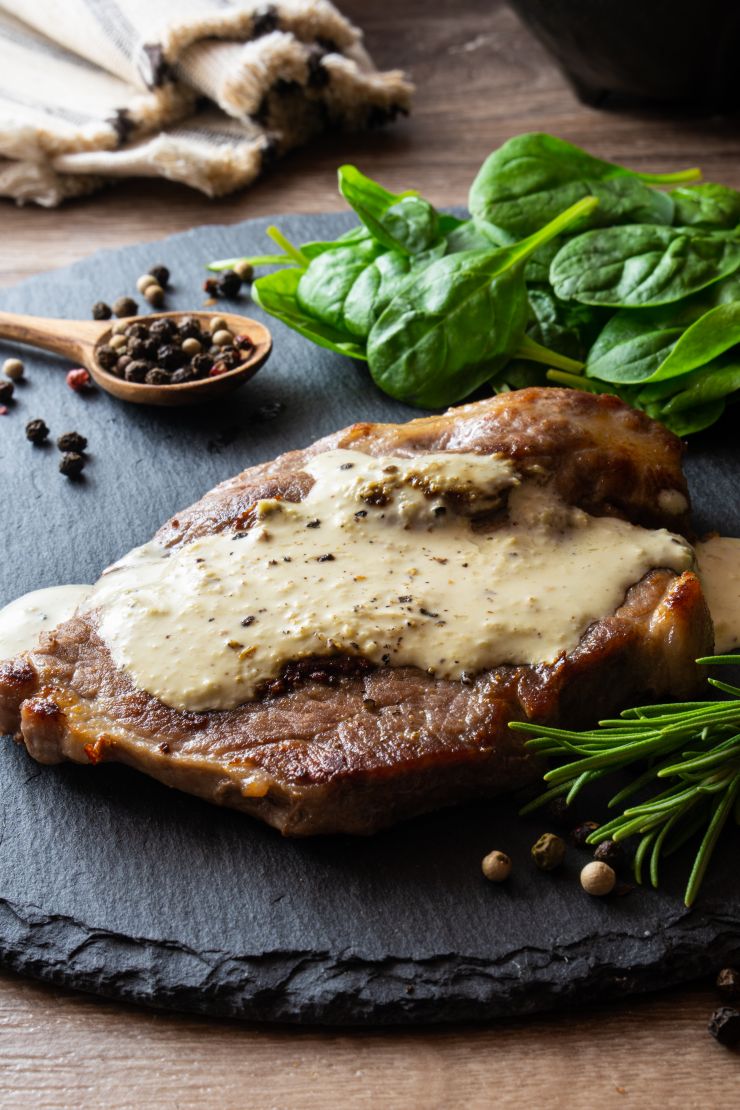
Pan Fried Beef Steak with Horseradish and Peppercorn Sauce.
Frying Meat can be tricky however it can also be ever so rewarding. Rendered on the outside, tender on the inside then you are in for a yummy journey. Everyone have their own preferences which is the trick to grasp over time. As per say for a Beef Steak for exemple, some will like them rare, medium rare, or completely done done like a shoe sole which could be classified as gone gone. It is all an entire matter of taste.
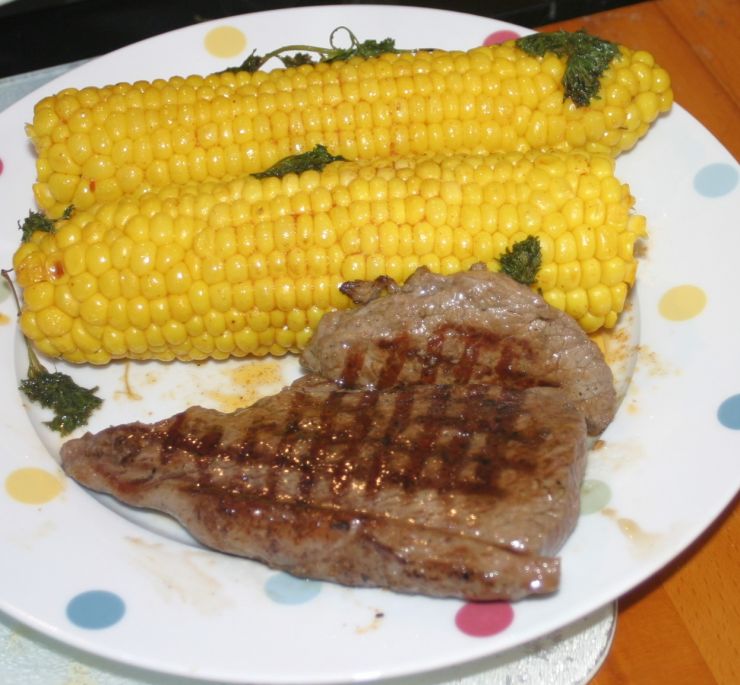
Beef Steak, (the Rump), Griddled Pan Fried served with Paprika buttered Corn Cobs. A simple Summer time Dinner.
To be honest with you they are multiple technics to Fry Meat, my favourite one is just to Pan Fry. Usually I do so in salted Butter with a dash of Oil for the Butter to not burn, then I baste the Meat. Additions can be chopped Shallots, chopped Garlic, Seasonning, Herbs. Although I do like to keep it simple, a tip is to not loose the juices which came from the cooked Meat in your pan. It can make the building block of a flavoursome Sauce to go with the Dish. It is a case of deglazing the frying Pan.
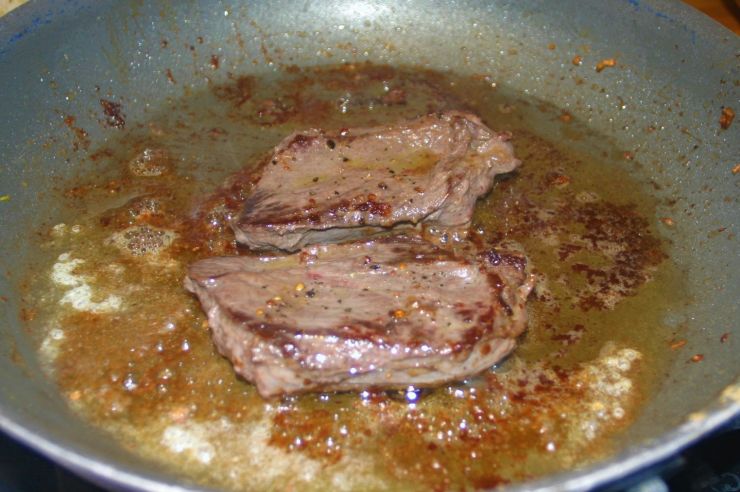
Pan Fried Venison Steak in salted Butter. When the Meat is rendered, it has a bit of colour around it. Then you can finish the cooking of the Meat on a low hob heat or in an oven for it can help to deal with the juices of the frying to turn them into a Sauce/Jus or Gravy. Let us not forget that there is a resting time for different Meat after cooking it. This gives us the time to create a Sauce or to reduce it down for even more rich flavours.
When the Butter in the Pan turns almost golden brown this is the moment when you do know you did hit the jackpot to create a decent Jus, Gravy or Sauce. You have the base for it, or what in French we call 'le Fond', hence the fondation for your Sauce. Then you need to deglaze the Pan the way you want and reduce your Sauce the way you like. To deglaze you do need a liquid agent which could be either Water, Alcohol, a Stock or even Fruit Juice. The important thing is to stay true to the flavours you want to give to your Dish.
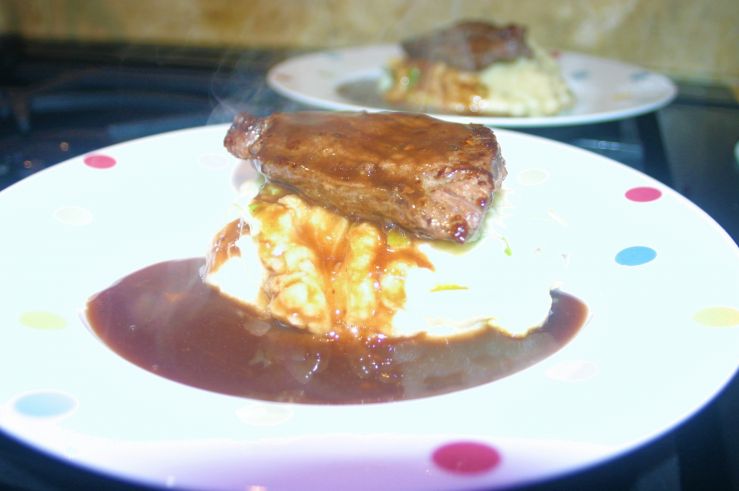
Venison Steaks served on a bed of mashed Potatoes and mashed Celeriac with a fortified Wine Gravy. It is a very Autumnal/Winter kind of Dish, one for the cold days of the year. The Dish could be improved by adding buttered Leeks within the Mash, but also by reducing the amount of Mash, which is very lush, nonetheless, on the plate. A Side could also be included like braised Green Beans with chopped Shallots and toasted Hazelnuts.
Use a wooden spoon to do your Sauce/Gravy when deglazing your Frying Pan for gently does it. Your Meat will be aside resting or in the Oven to finish off cooking. The spoon will help you to gather all the nice nutty caramelised flavours from the bottom of the Pan. Add your liquid agent. A little does a lot. But more does more if you have the time to reduce the Gravy on your hands. In my repertoire, White Wine Sauces go well with Chicken, but also with Pork. However my preference for Pork is Cider or even Pommeau or Calvados (go easy on this latest one for it has a high percentage of Alcohol so to flambé it, is advised if you can not reduce it.) Onion Gravy goes well with Pork so with a nice craft Cider within, it can make a simple dish of Sausages and Mash sing all the way.

Preparing a Sherry and Onion Gravy. The residue of a skillet, a frying Pan are full of goodness to be used up to their full potential. My other version is a Sherry and Shallot Gravy which goes well with Game.
Deglazing to make a Sauce or a Gravy or a Jus is a skill which should not be forgotten in the Kitchen for it makes the most and the best of everything. In terms of frying there is usually a notion of speed, however care can still be there which could be in the way the Meat is not overcooked and a Sauce is conceived in the meantime, together or apart. The resting time of the Meat can be the key or else... Devilled Kidneys (Lamb's Kidneys) can be Pan Fried for the best effect for exemple. The Devil Sauce as well as the Kidneys do the talking in that Dish, spread upon a nicely toasted thick slice of Sourdough Bread, then the yum yum goes even further.
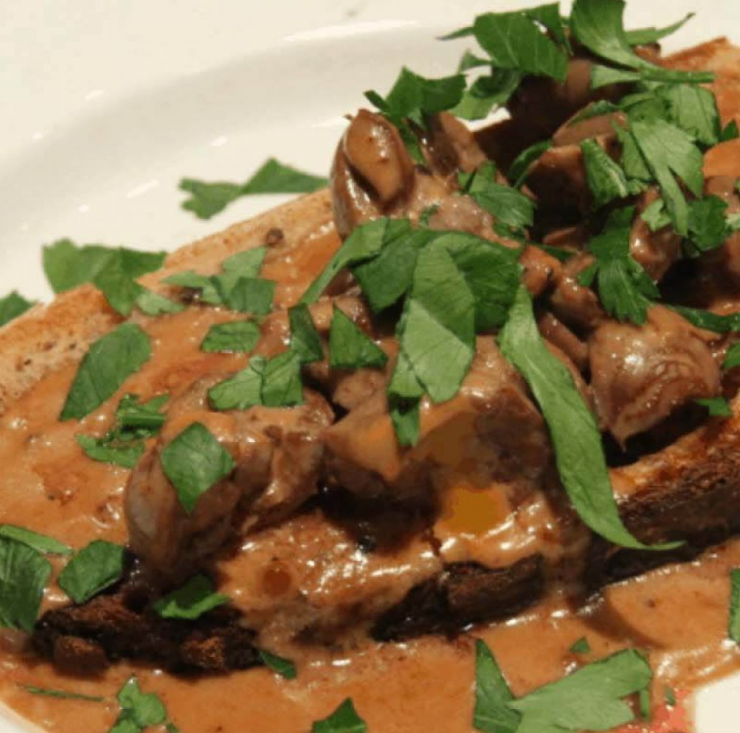
Devilled Kidneys upon Toast. This Dish makes a good Brunch. There are multiple variation of a Devil Sauce but the main ingredients are Mustard, Butter, Worcester Sauce, Pepper, Salt, and Cayenne Pepper. The Meat used is normally Lamb. The best one I ever had was in a Restaurant in Chapel Market, the Angel in Islington, London.
Offals do benefit to be Pan Fried. They do not take long to cook otherwise their texture can become rubbery. If I am not adverse to Kidneys and Liver, at home I am not cooking them because my Man calls the Offals: the Awful Offals. In my youth, I grew up eating a lot of them at the canteen at School and particurlaly, I disliked Heart and Brain. So let me tell you that I do not miss them. However if the chance present itself I would try Sweetbread.
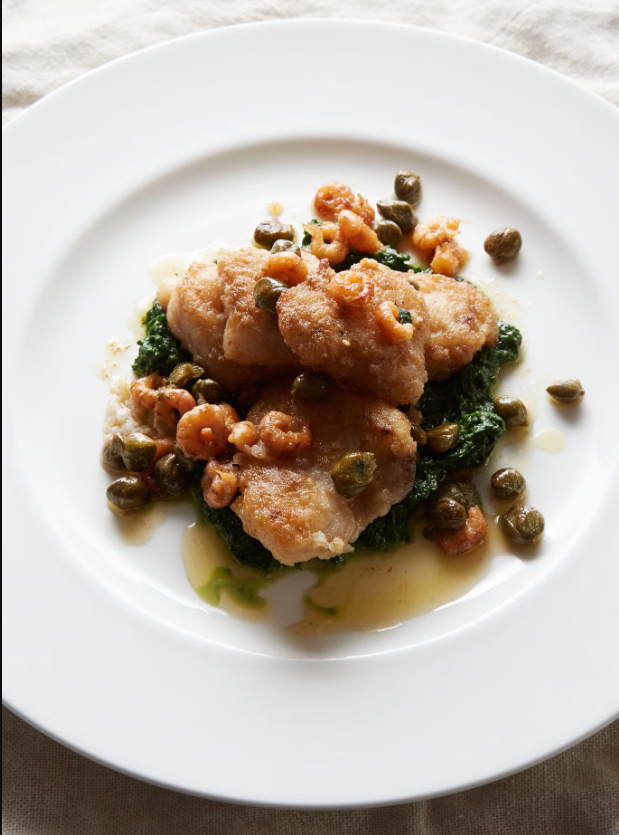
Pan Fried Sweetbreads on a bed of Spinach served with Shrimps and Capers, dressed with a Garlic Oil. It is a little Surf and Turf but can work as a Lunch, a Starter or a Supper.
To go back to our Sauces and Gravy, Onion Gravy pairs well with Liver and Mash Potatoes. It is a British Classic which I do enjoy on occasion mainly in Gastro Pubs or in Hospitals. My only complaint with Liver is that it can so easily be overdone to then taste like a rubbery leather shoe sole. Then the memory of my School's Canteen comes back to my mind... Many times I did miss recess for not eating my Liver at lunchtime. They would not let me go and play until I finished my plate... The Canteen Ladies were a force to reckon with. There was the very bossy Isabelle which you didn't want to cross. She had long black hair and green eyes and in a child's view, we thought she was a witch brewing stews above the Canteen's cooking pots. And there was the very coaxing, short red hair, with green eyes too, Diane, which would always encourage you to have another bite. We thought she was a witch as well but more of a fairy kind of type. She came with sentences like: the more you eat the less of your recess you will miss before your class start again. Memories of childhood, we can't replace them.
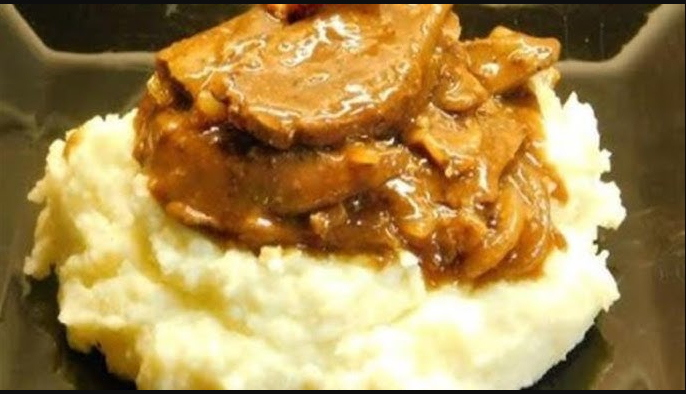
Pan Fried Liver with Carrots, Mushrooms, on a bed of Mashed Potatoes served with an Onion Gravy.
As for Red Wine Sauces or fortified Wine Sauces and Gravies, they do go well with Red Meat such as Lamb, Mutton, Hogget, Venison, Rabbit and Beef. Braising the Meat in hot Oil, or Butter and Oil first is always better to render it to give the Meat some colour. Then it is a matter of building up a Sauce to go with it. For exemple for Rabbit, it could be a Chasseur Sauce. Therefore it would be a matter of putting the cooked Meat aside to deglaze the Frying Pan then to build up the Sauce. First would come the chopped Shallots and Garlic within the Butter, then it is the Lardons and the Mushrooms before pouring the Red Wine. Add the chopped Tomatoes and a little Beef Stock or Chicken Stock if using. A table spoon of Tomato Purée does intensify the flavours so does a pinch of Ginger and a pinch of Paprika. Seasonning and woody Herbs like Rosemary and Thyme but also a Bay Leaf or two, and some chopped Parsley are necessary to give the Dish even more aroma. Return the Rabbit to the Pan then leave it to simmer in the Sauce for 45 Minutes. It does make a very satisfying Dinner.
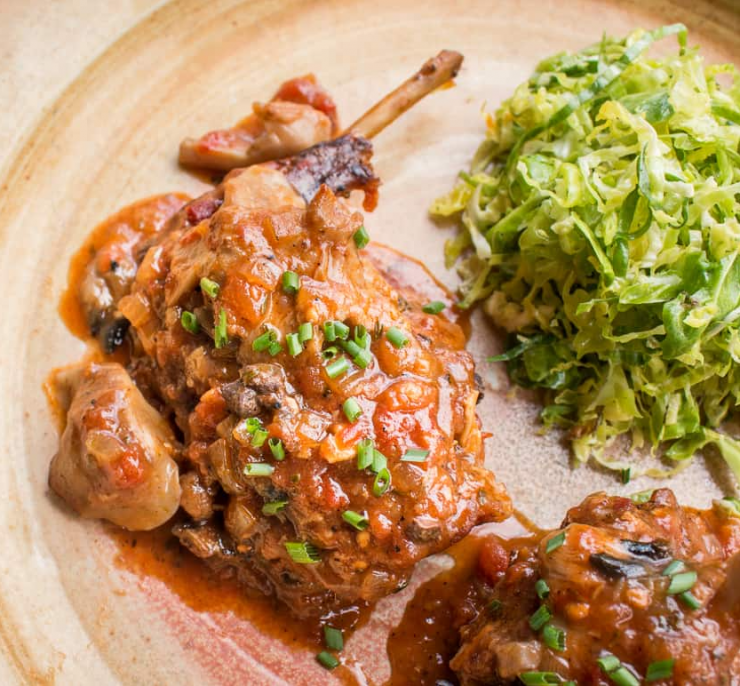
Lapin Chasseur (Rabbit à la Sauce Chasseur or also known as Hunter's Sauce). It served here with shredded lettuce and shredded Savoy Cabbage as a Side and topped with chopped Chives.
For Creamy Sauces, the trick is to not split them. However they are very satisfying. Creamy White Wine Sauce, with Shallots, Garlic and Mushrooms is one of my favourites. Swapping the White Wine for Cider is also an option for Pork. Milk and Cream have the abilty to tenderise Meat hence after rendering the Meat by Pan Frying it, if you return it to the Pan to finish the cooking of it, the Meat will have less chance to be very tough and to remain moist in the middle.
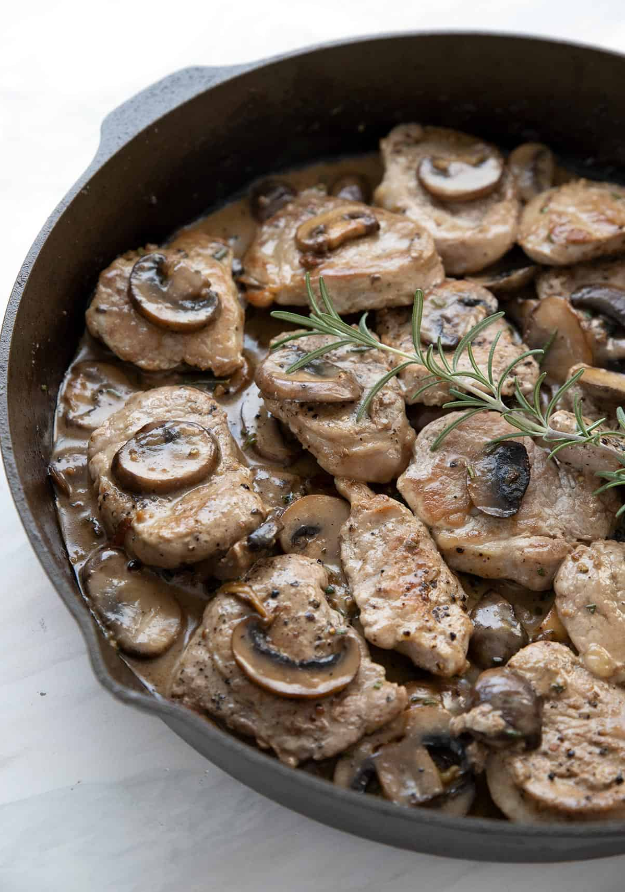
Pan Fried Tenderloin (Slices of Tenderloin are called Medallions, like above) of Pork in a Creamy Cider, Grain Mustard and Mushroom Sauce.
Pan Frying can be also done on a Griddle Pan. It is an effective way to not only render the Meat but also to give this flavoursome and appetising pattern upon it. One tip of Chef for this method is to align the Meat vertically first and then to place it horizontally to get the perfect grid upon the Steak or the Chop. Another tip is instead of putting the Oil upon the Griddle Pan, it is to brush it across the piece of Meat for better results.
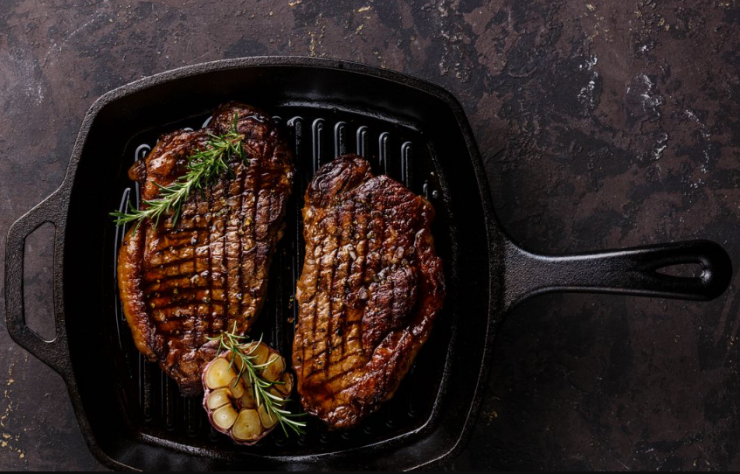
Getting the Griddle marking right can sometimes be tricky. But Diamond shapes griddle marks are as hard to get as the square ones.
As a rule of thumb, for a Beef Steak, it all depends of its thickness to get it cook. I was told that on average it takes two to three minutes on one side then the equivalent time for the other side to have a Medium Rare Steak. The cuts of Beef best for Frying are the Rump Steak, Sirloin, Fillet Mignon, Chateaubriand, Porterhouse Steak, Skirt Steak, Rib-Eye Steak, Flank Steak, T-Bone Steak, Short Strip Steak, Beef Tongue and Hanger Steak.
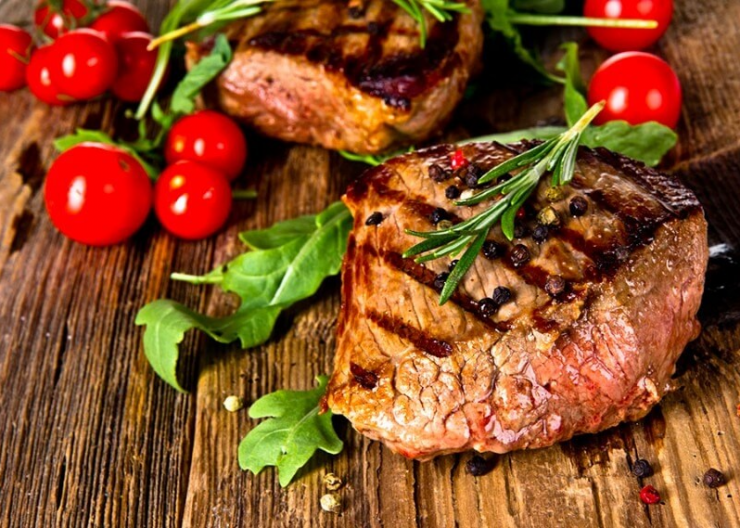
Griddled Chateaubriand Steaks. The Chateaubriand is a specific cut right in the middle of a Beef Tenderloin. The Tenderloins are long but the middle part of them is the most tender hence it is the most sought after. You can always ask your Butcher for this specific cut.
As a personal preference I do like Steak and Chips but I usually choose the Rump Steak. Sirloin is said to be better though but I find it leaner, so I prefer the Rump. The marbling on the Meat is an important key factor because it does impart flavour. It is the same when you have any piece of Meat with a bone within it. It does infuse taste throughout, part of it is because of the Marrow within the bone. Hence a T-Bone piece of Beef is a delight to eat.
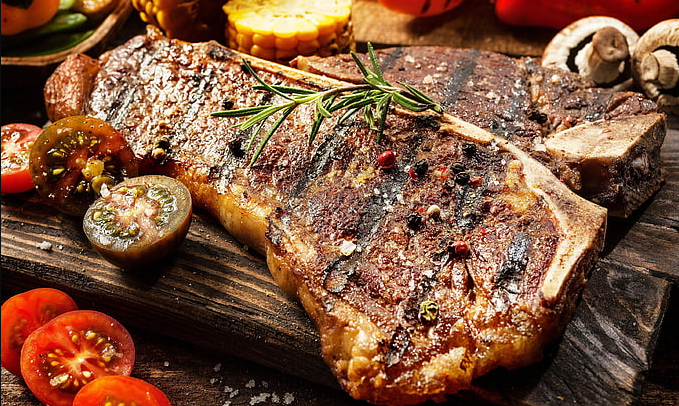
A Griddled T-Bone Beef Steak seasonned with Peppercorn, Sea Salt and Rosemary. It is such a piece of Meat that serving it with Sides can be as light as Tomatoes slightly roasted, Corn Cobs cooked en papillote, and Chestnut Mushrooms preferably sautéed with chopped Shallots and a little crushed and peeled Garlic.
The Marbling, the white is as per say fat. The Marbling makes the Meat easier to chew, because it tenderises the fibres of the muscles of the Meat. It makes it moist, juicy and tasty as well. A famous one is the Wagyu Beef.
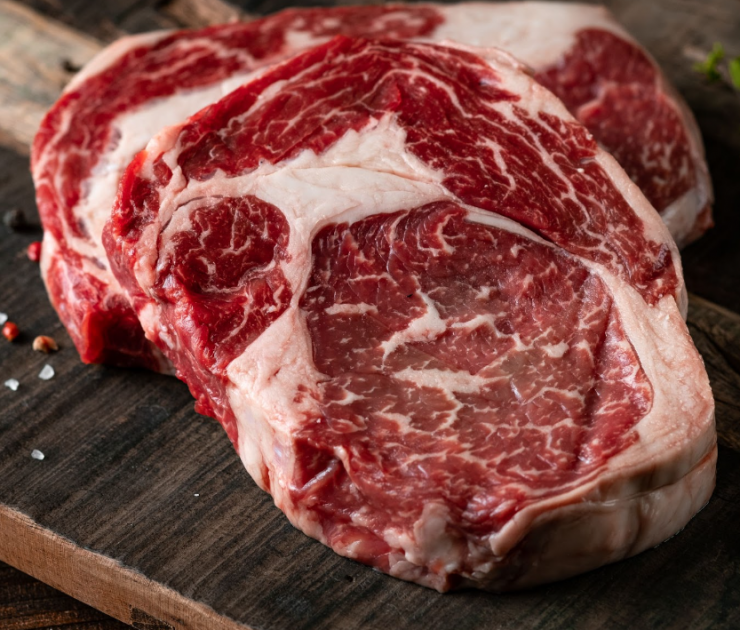
British Wagyu Beef Steaks.
However there are controversies about how the cattle is raised: One being that the cows are being force fed and not being allowed to graze on pasture most of the time. Is it the price of fat to render a Beef obese? Wagyu is made from about four different species of Japanese Cows which have been cross bread with European ones.
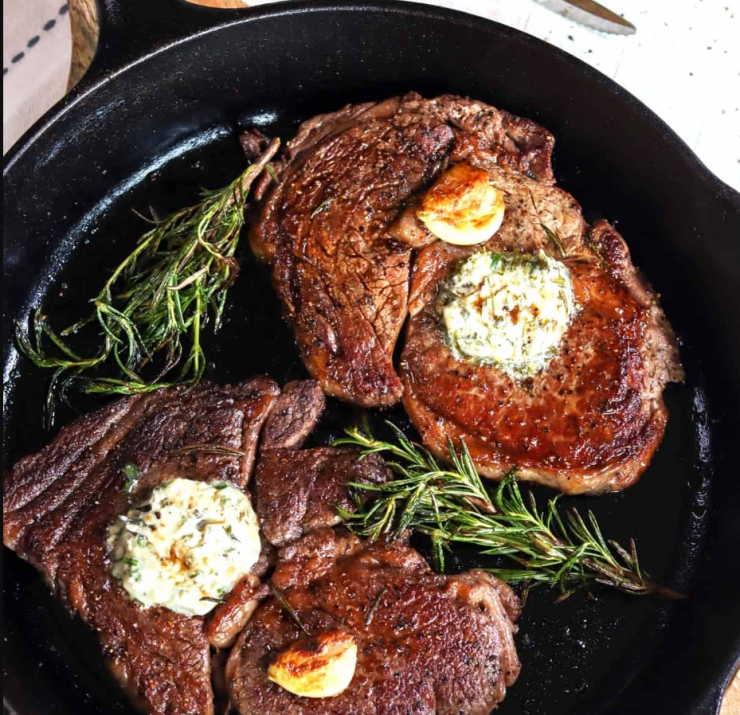
Pan Fried Wagyu Beef Steak with Garlic and Herbs Butter.
Of course in terms of Pan Frying or Deep Frying, we can't escape the matter of Fat because it is the way to cook the Meat with. My choice is to go for Salted Butter, especially the one from Isigny sur Mer. My second choices are the Farmhouse Butter from Sainsbury's, the Beurre Président, and Kerrygold. Now a dash of Oil prevent the Butter to burn too much. We want a good colouration which is golden brown, almost Hazelnut in shade.
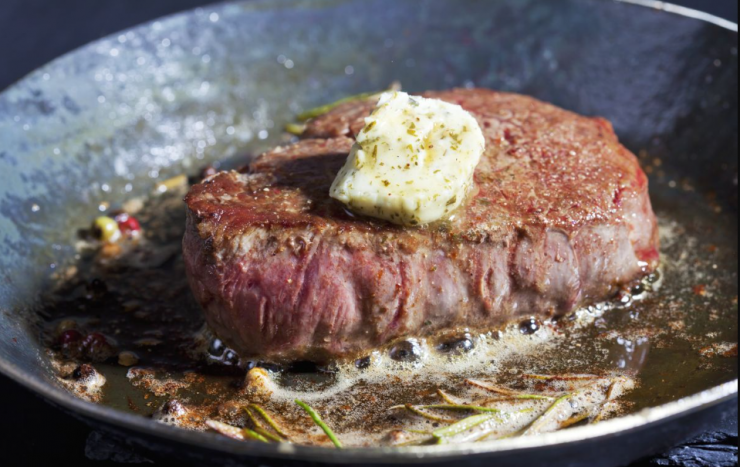
Rump Steak rendered within a Herby (Rosemary, Thyme and Garlic) Butter. Nothing stops you to add more flavours upon your
The choice of Oil depends upon taste and what you want to achieve: For you can go for a fairly neutral Oil or one which is flavoured. To Deep Fry I mainly use Sunflower Oil, but also Rapeseed Oil. If I am Stir Frying, then I become more adventurous therefore can opt for Peanut Oil, or toasted Sesame Oil, or even Chilli Oil. When I am cooking a Dish more Western than Asian then I do go for Olive Oil, Garlic infused Oil, Basil infused Oil, Truffle Oil or Walnut Oil. Your choice of Oil does add another taste to the Dish, another layer of flavour.
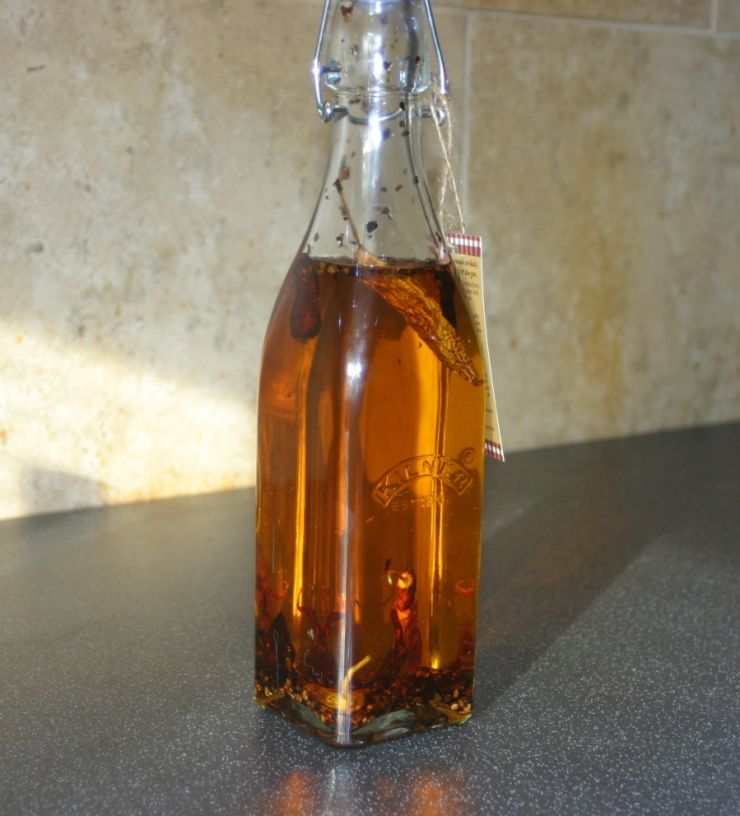
Home Made Chilli Oil. It does give a nice kick to a Stir Fry.
Very rarely I do Deep Fry Beef. For me it is mainly the Pan Fried way. However I prepare it, especially in Summer, with very slim Steak ( You can gently hammer the Steak to make it slim), you can make strips out of the Steak to slide upon a skewer in a 'S' shape. Those Beef Skewers go well with Fried Baby New Potatoes Skewers. They can be accompanied by Tempura Broccoli florets. The condiments/dips prepared could be a Chilli Mayonnaise, a Sesame and Spring Onion Soy Sauce Dip, a Szechuan Sauce, and/or a Sweet Chilli Sauce. It does make a Saturday Night little Feast.
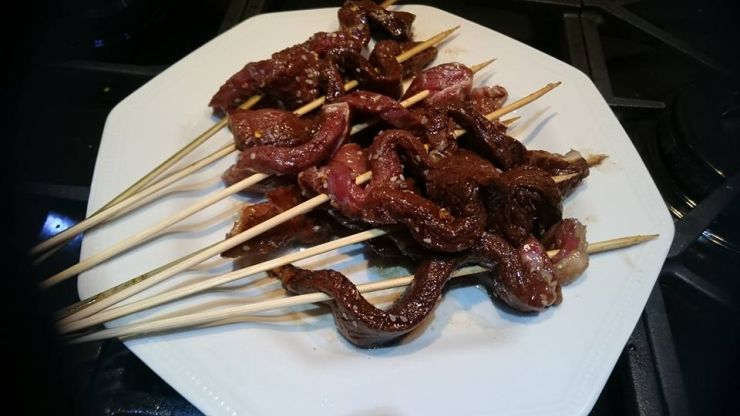
The Spicy Beef Skewers. The deep Fried Meat was marinated beforehand to give it more of a hit of heat. Marination is a process which not only impart flavours to the Meat but also tenderises the fibres in your Meat. Hence you will still have tender Beef after deep Frying. If the Marination can take up to 24 hours, the deep Frying take only minutes.
From Beef, we can turn to Lamb which I actually prefer to render by gentle Pan Frying or Griddling. Let us just say that I am fond of Lamb Chops and Lamb Cutlets most of all along with Lamb's Steaks... From Easter time to the end of Winter, this is the time where we eat Lamb. Easter Lamb is as traditional as we eat the Turkey for Christmas, however it is from Autumn when you will get the best grass fed Lamb from the Northern Hemisphere. Otherwise when it is Spring you can enjoy the most of New Zealand (Southern Hemisphere) Lamb.
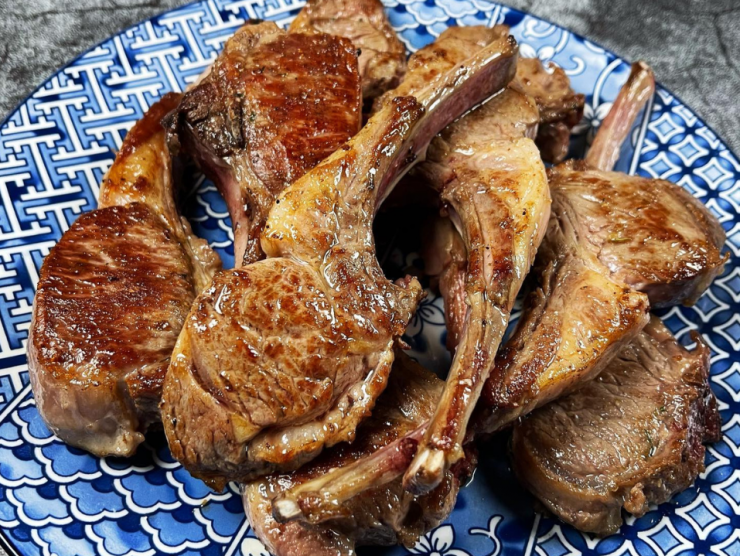
Pan Fried Lamb Cutlets. The fatter they are, the more succulent they are also.
You can French trim the cutlets, chops or rack of Lamb so they will look much neater on a plate. The method consists not of removing the bone of the Lamb but to make it look clean and presentable. Therefore the bone is stripped of sinews and of its fat. To be honest although French, I hardly use this method at all. I like to leave my Lamb rather alone myself to remain lush and fatty. Apart for the Rack of Lamb then I polish off the stance.
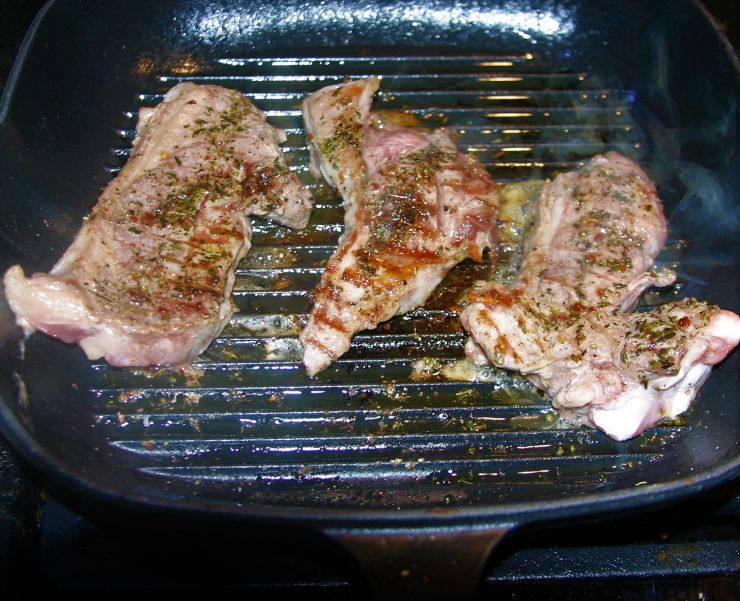
Griddled Lamb Steaks seasoned with Herbes de Provence getting done.
Fried Meat is the source of many popular dishes worldwide. To mention a few I will say: the Schnitzel, the Cordon Bleu, Chicken Kiev now Kyiv... Originated from Austria, the Schnitzel was reported to date roughly from the mid 1800's because it was then first mentionned. Viennese (or Wiener) Schnitzel is considered as one of the national dishes of Austria. It is usually made with Veal Steak, the Escalope, rendered very thin by either rolling or hammering (using a rolling pin either ways), then it is Breaded (Flour, Eggs then Breadcrumbs process) and fried. The entire operation do not dry out the Meat on the contrary, it tenderises it. Hence it is moist whilst you eat it and you do have a contrast of texture because it is crispy on the outside.
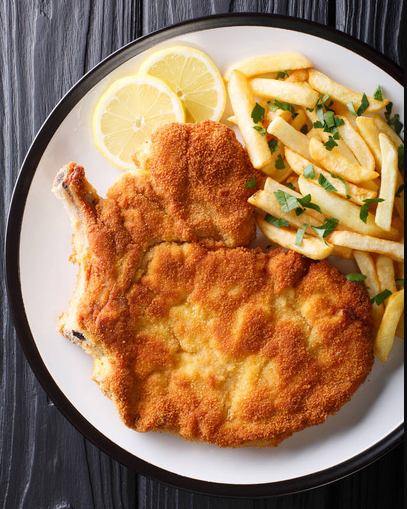
Fried Veal Schnitzel. It is served with Lemon by tradition. The Sides for it usually are made with Potatoes, like a Potato Salad, Potato Wedges with Butter and Parsley, Crushed Potatoes, Buttered Mash Potatoes or even Chips... If it is Pan Fried and not Breaded then a creamy Sauce with Mushrooms is an accompaniement for it.
The Schnitzel is traditionally made with Veal but it can also be made from Beef. It is a result of husbandry. When you have a herd of Cows which are intended for dairy, you do discard the male Veals eventually. It has been a practice for centuries. The lucky males became Bulls able to reproduce with the Cows, with the unlucky ones becoming Meat. Hence Veal is a produce of Dairy Farming.
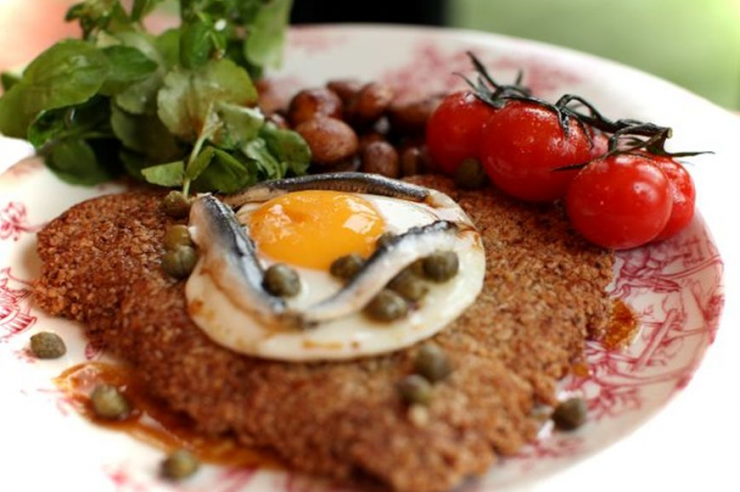
Another version of the Veal Schnitzel is served with a fried Egg, Anchovies, Capers and Tomatoes. It is also known as a Holstein Cutlet. It is usually accompanied with a side Salad.
Schnitzel are also translated as the part of Meat used which is often called the Cutlet or the Escalope. Therefore it can be from the one of a Turkey, the Breast of a Chicken rendered flat opened, or even Pork. One thing remains is that pink to white Meat is prefered for them. The interpretation of this Dish went so world wide that its true origin are quite unclear. It is probably a question for Shakespeare: To bone or not to bone? Is it that what does truly make a Schnitzel is to be without the bone...? Well for the Veal Milanese, it is supposed to be with it. But it is a similar recipe with very little variations.
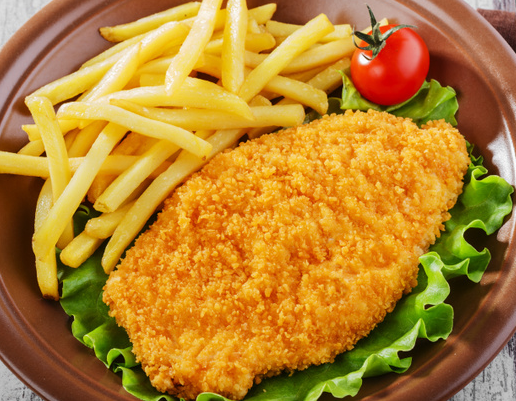
Chicken Milanese served on a bed of Butterhead lettuce and Chips.
For the Cordon Bleu, it is another variant of the Schnitzel. It also uses either Veal, Pork or Chicken. The difference there, is that it does have Ham and Cheese inside the pounded Meat which is then breaded and fried. It can be presented also as a roll. A Cordon Bleu is rather an indulgent affair. The fact that a Cordon Bleu is filled renders it very similar to a Croque Monsieur which is another Bistro or Gastro Pub favourites.
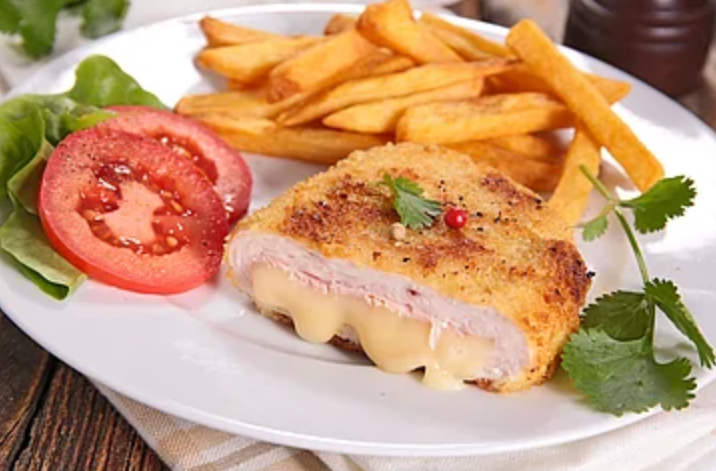
Chicken Cordon Bleu served with French Fries, a little Salad with sliced Tomatoes. The origins of the Cordon Bleu are from Switzerland, hence the Alps which are shared with France, Italy, Liechtenstein, Austria and Germany. All of those countries have a historical Dairy farming past and present.
Then there is of course the Chicken Kiev/Kyiv, popular almost worldwide. Classified as Haute Cuisine in the early part of 1800's, it is done with a part of the Chicken which is called 'Supreme', the one which is qualified to have most quality and tenderness. In fact it is the white of the Meat which you would be looking for, the one that can be the most transluscent when it is folded around a Herby cold Butter center which will melt inside the Meat while frying it.
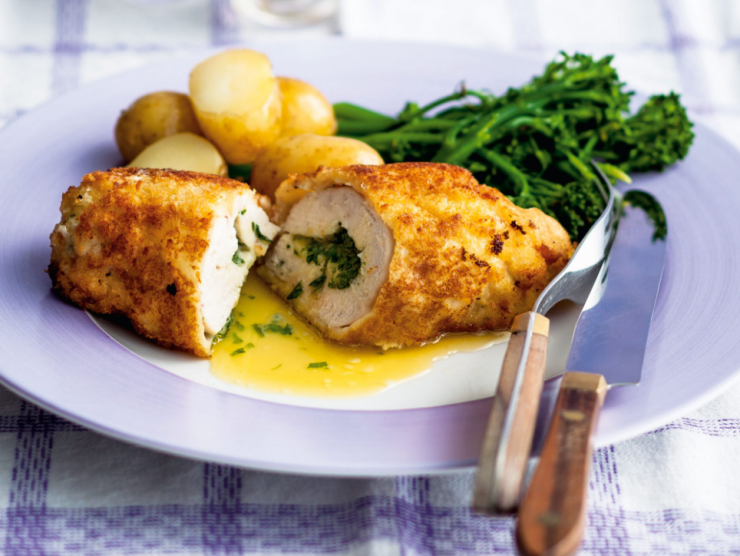
Pan Fried Chicken Kiev/Kyiv served with boiled Baby New Potatoes and Tenderstem Broccoli. To Pané the Meat is a must. It is wrapping the Chicken Suprémes in a coating of a little Flour, Eggs and Breadcrumbs. Now, inside the Chicken to be rolled there is the Butter which you can mix, prepare yourself to your own liking. The Herbs involved could be Dill, Parsley, Chives... and Wild Garlic. Or the Butter could even contain chopped Garlic. The essence of this, is that the Butter ouze out from the center to bring flavour to the plate.
Breaded and Fried Chicken are mainly done with the Chicken Breast but also with the Wings, Drumsticks and Legs. Chicken Strips and Nuggets are ever so popular that we have them in sharing buckets. It is convenience food at its best: Fast, tender, crispy and fulfilling. It is perfect to have such a Meal while watching a good movie on the big screen or the TV on Saturday nights.
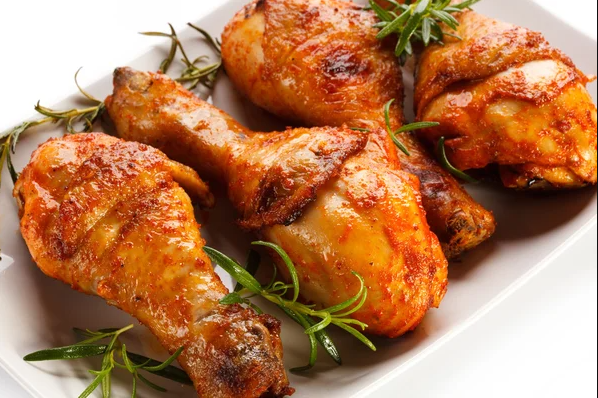
Fried Sweet Chilli Chicken Drumsticks. A coating of seasoned Flour (the pinch of Cayenne Pepper is optional) comes first then it is a good rub into the Sweet Chilli Sauce or Jam before the Frying. Panko Crumbs and Chilli Flakes can also be added before the Frying. Those could be served with Noodles or Rice for an Asian vibe or Spicy Potato Wedges and Sweetcorn for a South American vibe.
In essence Frying allows one to cook faster. But it doesn't mean that the outcome will be without taste whatsoever or either dry beyond belief. Indeed as we mentioned the choice of Oil or Butter is important. But also simple technics such as basting the Meat while cooking it do provide more taste. We mustn't forget the importance of Sauces, Jus and Gravies which we can build with the residues of a Frying Pan. There are lots of flavours in there to be had by deglazing the Pan. In terms of Frying, again, there is an enormous opportunity to season a Batter or the Breading of the Meat. It doesn't have to be blend. It is like putting spice back to life with a good Fry up.
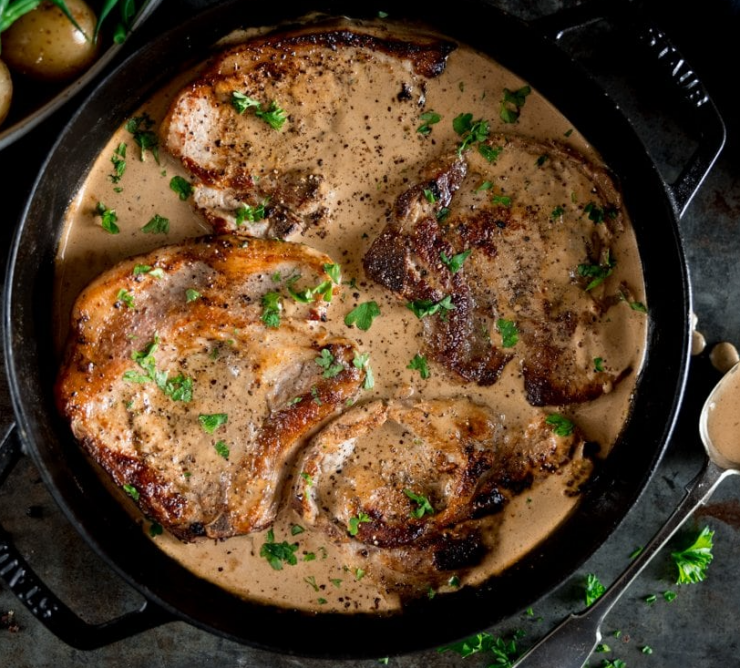
Pan Fried Pork Chops within a creamy Mustard Cider Sauce: Memories of Normandy.
